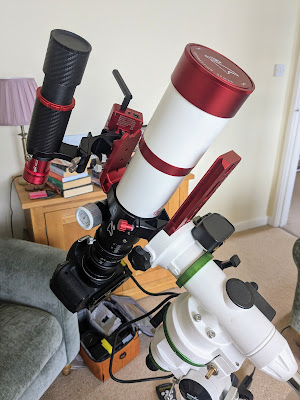I have rarely ever been in the right place at the right time. Until now.
I was scrolling my Facebook astronomy/astrophotography groups looking for tips and information about something else, when I spotted a post offering a skywatcher mount free to a good home or club.
I waited for an hour or so and no one had commented, so I took the plunge and contacted the gentleman, who as it so happened, lived relatively local to me.
And so I now own a third hand EQM 35 Pro mount and tripod. The only stipulation, if I don't want it or I outgrow it, I pass it on for free and of course, it goes without saying, look after it. I did offer money for it but it was politely refused. I did offer to donate to a charity of the gentleman's choice but it was politely declined and I was told I was THE charity!
Now, as it so happens I am looking to buy a new mount. I've been considering three - the SWSA gti; the EQM 35 Pro and the EQ-AL55i and I had a very productive visit to a well known astronomy retailer two days ago just before discovering this Facebook post today. I needed to buy some bits and pieces, a new power tank etc and so I so I did spend some money on various upgrades etc at the retailer, so they didn't lose out. If the EQM doesn't fit into the motorhome, then I will be passing it on and probably getting an EQ-AL55i or even a HEQ5 from the retailer.
So, what have I been so generously gifted?
The first and second owners have only used it a few times. It is pretty much pristine with very few signs of any wear and tear. The Declination - rotates freely without any stickiness or slowing. Rotating the RA axis is stiffer. When balancing the payload, if the counterweight is pushed to the lower end of the support bar then it rotates freely but move the CW further up the bar and the rotation is less free.
Its the grease used by Skywatcher. And the fact that it doesn't use bearings, just bushes. There are YouTube tutorials about how to free up the RA a little - it involves removing the polar-scope, finding three little grub screws; loosening them 1/16th of an inch at most. An aluminium disc can then be removed giving access to the 'nut' which can be loosened a tad. That will allow freer rotation as along as I'm careful not to introduce any 'play'.
However, I don't feel brave enough to do this. The mount is a generous long term loan - it has to be passed on. I don't want to mess this up. I understand the contract!
So far, I have managed to link up my ASIair mini via an EQMOD cable - i.e. not using the accompanying SynScan handset. I can make the mount slew in all directions. I can't get it to communicate using a usb cable into the control box. The handset seems very hit and miss despite following the instruction book very carefully.
I tried it out last night before the clouds closed in and some issues emerged rapidly.
1. I could not get it to line up with Polaris, however hard I tried. I lost forty minutes there until I worked out that the little spirit level bubble on the mount is broken. So when I was levelling up the tripod using it, I was way out! On a completely level surface, the bubble is well to the back edge - nowhere near the circle, never mind the centre of it! So, I am levelling the tripod before the mount goes on, using a longer spirit level. Irritating but only in a very minor way.
2. After an SWSA 2i on a WO wedge, this one is so easy to polar align using the ASIair. Oh my. Very small precise adjustments. Complete revelation.
3. Switching on Dec for the first time in the AA mini - some new learning when calibrating - west and east steps and then north and south steps (new to me) and then backlash steps? And then the clouds closed in before I could do any more!
4. I'm not completely sure whether it is going to its nominated target accurately enough - I tried for M3 and it seemed to be slightly off. But then I haven't used the space atlas icon before in AA so that's a new one on me too. More learning to do over next few nights.
The EQMOD cable is a loose fit and so I may need to get a new one. I need to get a longer dovetail bar for my zenithstar 61ii so that I can do better Dec balancing. I need a small finder plate bracket to attach to the scope to hold the AA mini. Before, I've attached it to the tripod.
So, plenty of new learning. Reviews about the EQM are generally sound - although clearly people are unhappy about rotational issues and the knock on effect in guiding when using an ASIair. I need to update the software/firmware. I'm not sure how old the mount is but I suspect its three - five years old.
It uses the plug in polar illuminator - yep that one - from the SWSA2i - the feeble red diode one! But that is a minor, minor niggle.
I will let you all know how I get on. I feel very privileged and a great weight of responsibility to get this EQM 35 Pro mount working properly; to make best use of it. I am its 'custodian' for a time.
















